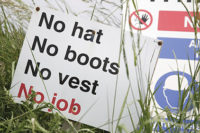
Safety analytics is an emerging science that is helping to drive improvements not only in workforce safety and health programs, but also in overall business performance. Deloitte Consulting, a leading practitioner in this field, defines safety analytics as “the science of studying the underlying causes of and contributing factors to workplace accidents.”
On the surface, that may sound similar to what top workforce safety and health professionals have done all along. But what’s new is the amount and range of data that can be analyzed. For example, part of what distinguishes safety analytics from past practices is the use of external data (demographics, lifestyle indicators, industry financial data, etc.), as well as traditional historical and observed data. Among other benefits, this approach helps to ensure that human variables are appropriately weighted in identifying risk and taking appropriate preventive actions.
Combined with the growing use of leading indicators, leveraging safety analytics gives you a more complete, and more current, picture of everything from specific work processes and locations up to the health of your safety culture in general. This, in turn, leads to a more targeted, proactive allocation of available resources for:
- Workplace accidents and injuries
- Compliance
- Productivity
- ROI on safety expenditures
- Employee satisfaction, morale, loyalty andretention
- Absenteeism
- Product/material damage
- Managerial efficiency and effectiveness
- Corporate reputation
How safety analytics work
Its power is fundamentally predictive - on the most basic level, the tools and methods of this science help workforce safety and health professionals to more quickly and more accurately identify the jobs, processes, locations, groups of individuals, conditions and so on that represent the most immediate, severe or costly risks.
For example, one tool that is especially powerful with safety analytics is a Risk Severity Index (RSI) - a formula incorporating weighted variables like expected frequency of an unsafe behavior, nature/ severity of injury/loss if uncorrected, number of people potentially affected, and more. Such an index, tailored to your specific workplace, provides a consistent, objective guide for prioritizing the most urgent safety and health risks that need to be addressed. Resources - and especially time - are always limited, and an RSI helps ensure that training and other preventive measures are directed where they’ll have the most impact. Clearly, if a process has a high probability of unsafe incidents and such incidents could shut down production or lead to severe injury, that merits greater attention than processes that rarely go awry and have minimal consequences.
Some of these distinctions may be obvious in a given industry or workplace, but others are more subtle - though no less costly - and are rarely caught until after an incident occurs. By focusing more attention on leading indicators rather than relying primarily on lagging indicators, safety analytics helps you make these critical distinctions before incidents occur.
Applying safety analytics
No one would argue against the value of a science proven to lead to a safer, healthier and more productive workplace - but since it’s a science, not a magic wand, we need to address the question of how to apply it. What methods and tools define the science, and how do they integrate with existing programs and processes? The specifics of safety analytics - like safety, health, training, compliance, risk management and related efforts in general - vary to some degree depending on industry and work environment. Here we’ll focus primarily on the principles, approaches and commitments that are crucial in any implementation.
First, safety analytics requires an organizational commitment to carefully planned and monitored systems and processes, and to enterprise- wide accountability. As with safety analytics itself, this is greatly aided by the use of the latest software tools and systems that automate scheduling, tracking and reporting, centralize data for diverse groups, departments and locations, and ensure clear communication and visibility around your occupational safety and health programs.
Second, the value of safety analytics depends on the quality, and in some cases quantity, of data collected. Even the most sophisticated predictive models won’t be very useful if data is incomplete, inaccurate or willfully manipulated. Regular safety inspections and audits, already an industry best practice, are critical. But it is important to emphasize that safety analytics should also incorporate external data such as behavioral and lifestyle indicators. Combining such information with credible, timely observation data is what makes safety analytics so effective in prevention and loss control efforts.
Key data sets
Keeping in mind that the “best” specific data to use will vary slightly by industry and organization, here are some key categories: employment history (including wellness program participation), employee demographics (including commuting distances), operations data (injury rates), work performance data (annual evaluations, compensation, etc.) claim data (medical histories, etc.), and external data (neighborhood demographics, lifestyle indicators).
It has become increasingly clear that human variables - such as lifestyle indicators and other publicly available data - are also incredibly valuable in identifying groups of employees or contractors who may have a greater chance of sustaining a workplace accident or injury.
Non-safety parallels
If you have any doubts about gathering and using such data as part of safety analytics, consider some parallels outside our industry. Both brick-and-mortar and online retail settings, for example, routinely collect and analyze purchase data, demographic and location data, and other publicly available information to better match coupons and recommendations with individual consumers.
Another example is insurance underwriting, where such data is used to calculate automotive and homeowner’s insurance options and pricing.
Safety analytics can deliver powerful insights to help an organization better decide the what, when, where and how of workforce safety and health efforts, but follow-through from management and adoption on the front-lines remains the key to success. Safety analytics often identifies a need for change, which inevitably creates challenges. The good news is that because safety analytics has the safety and health of employees as a primary objective, it is often much easier to gain support for such changes.
Implementation
As always, implementation must also include a plan for how success will be measured. Safety analytics is meant to be part of a continuous improvement cycle that delivers sustainable results. Attention should be paid not just to short-term gains in traditional quantitative metrics, but also to whether you’re building a safety culture that earns the respect of peers, delivers an ROI in terms of reduced losses, and gives your organization a competitive edge.
Safety analytics is closely tied to an important shift in our industry from relying on lagging indicators to tracking and using leading indicators: number of inspections/audits completed, percent of compliant/ safe conditions, percent of employees trained, etc. in an ongoing way. They make it possible to take more proactive prevention measures - to correct problems before they show up in lagging indicators.
With that said, we should clarify that the value of leading indicators doesn’t mean anyone should depend solely on them. A complete and accurate picture emerges by correlating leading indicators with appropriate lagging indicators. If we’re looking at employee involvement in a safety program, for example, the leading indicators would include percent of employees involved in the safety decision-making process and the number of safety committee suggestions and projects; lagging indicators would include number of work method changes and average time to implement suggested corrective actions.
Performance management systems
Safety analytics is only effective if there is an organization- wide commitment to planned processes, systems and overall accountability. A number of factors should be considered in implementing a performance management system:
- All aspects of the system must be clearly defined.
- Processes and outcomes must be tracked and reported. As the old adage says, “what gets measured gets done.”
- Achievement must be recognized with appropriate rewards and incentives.
- All levels of management must be held accountable in the system and there should be an element of continuous improvement.
- The elements in the system must be statistically reliable based on easily attainable data. Safety inspections and audits - mentioned earlier in the context of data gathering - are also very effective in ensuring accountability. Inspection data is an immediate measure of current safety performance.
The future is here
“Survival of the safest” may well be one of the laws of the evolving global economy, and safety analytics is the fundamental science of measuring, assessing, and directing efforts to create the safest possible environment for employees, contractors, customers and communities. If you’re not already leveraging the power of safety analytics and leading indicators, it’s time to start moving in that direction. It’s more efficient, more effective - and it drives results.

